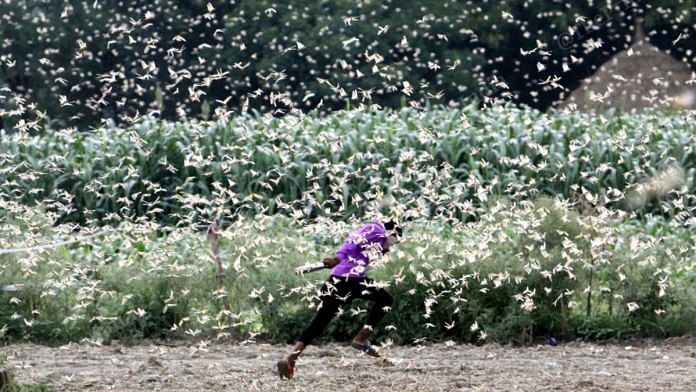Bengaluru: Scientists in China claim to have identified the trigger that makes migratory locusts swarm, pegging the tendency to the pheromone 4-vinylanisole (4VA).
According to a study led by researchers from the Beijing-based Chinese Academy of Sciences, the chemical was found to affect migratory locusts specifically, and induce gregariousness, the physiological need and ability to swarm with others.
The study was published Wednesday in the journal Nature.
The research comes on the heels of one of the worst locust plagues in decades that travelled from the Horn of Africa and the Arabian Peninsula onto Pakistan and India, heavily devastating crops all along the way.
Also known as 4-methoxystyrene, 4VA is emitted by locusts when they are surrounded by other locusts in close proximity. It was previously known that physical stimulation by touch on their hind legs, from other locusts nearby, is what makes a locust want to swarm. The exact pheromone that is triggered during the process is 4VA, the researchers have said in the study.
The study, the researchers added, contains potential clues on mitigating the threat presented by locust swarms.
Locusts can eat their body weight in food, and their swarms can contain billions of individuals that cover thousands of square kilometres, destroying all kinds of vegetation. Locust swarms have been a persistent threat to farmers, posing a particularly great risk in nations that already suffer from food insecurity.
Also Read: Locust swarms spare Delhi but threaten Rs 40,000-crore sugarcane economy in UP
Role of 4VA
Gregariousness is when locusts, which are just voracious grasshoppers, undergo physiological changes that enable them to attract other locusts and acquire the ability to fly. This is facilitated by 4VA, which is an aggregation pheromone. As the adjective suggests, it is emitted to attract other locusts, which in turn start emitting it after aggregating.
Locusts are believed to become gregarious when they constantly touch each other on their hind legs.
The touching and tickling of hind legs releases a large amount of serotonin, a ‘happy hormone’ also found in humans and released in the body during exercise. Previous experiments have shown that this can occur in as few as 10 locusts if they are tightly packed, but the new study suggests it can occur in four to five individuals as well.
The process of gregariousness also induces changes in appearance, turning locusts from green to a shade of yellow-brown, and strengthening their muscles. It is as yet unclear if 4VA causes only aggregation or also induces these physical changes.
The pheromone 4VA was the only compound emitted by the locusts that was found to attract both male and female locusts, of all ages, equally. It also worked both on solitary as well as gregarious individuals, the study says.
When locusts swarm, they adopt aligned movement and fly or march together. Nymphs, which are the flightless young of the locusts, march, and fly when their wings sprout.
4VA for locust control
Locusts can sense the pheromone 4A through neutrons in their antennae. To humans, 4VA, a volatile odorant, manifests as a sweet smell.
Scientists involved in the new study said they were able to isolate the specific protein that acted as a receptor in the insects for the 4VA molecule, the OR35. Proteins are encoded or produced by genes.
To confirm their findings, the researchers also created genetically modified locusts that lacked the Or35 gene using the gene-editing technique CRISPR.
Upon further testing, they found that the genetically modified locusts did not respond to 4VA.
The findings mark a crucial step in research into locusts as they provide the first solid step in engineering a method to control locust swarms. The pheromone 4VA, scientists said, can also be used to create traps to lure locusts. Molecules could be created, they added, to block the OR35 receptors, and locusts could potentially be genetically edited to not swarm.
Also Read: Why the worst locust attack in decades has invaded north India




So out of serotonin and 4VA which is responsible for gregarious behaviour of locusts?